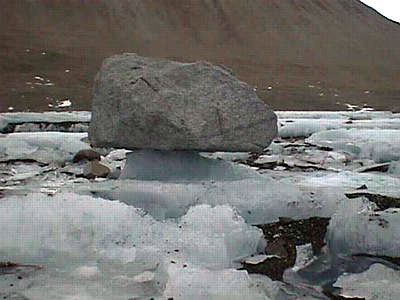scale
Procedure
Activity:
1. Your group should have 5 rock or mineral samples. Your teacher will tell you the
names of each sample so you can fill in your chart below. Weigh each one and record
its weight before.
2. Before "weathering" your rocks, predict the effect on each one. If you donít want to
predict a specific weight change, rank your rocks (1 meaning it will change the most,
5 meaning it will change the least).
3. Fill your jar 1/4 of the way with water. Place the first sample in the jar, screw the lid
on tightly, and shake for five minutes. Remove the sample and dab dry with a paper towel.
Get rid of any loose sediment. Weigh again and record the weight under weight after.
Repeat this procedure with the other samples. Use the observation column for any changes
that you can readily see (size, color, or shape).
4. Clean up your work area. Complete your chart information, using the formula below to
find your % Changes.
6. Designate a spokesperson to record your % Changes for each sample on the classroom chart.
Answer the questions in the analysis section below.
|
Rock / Mineral |
Weight Before |
Weight After |
Change in Weight |
Observations |
% Change |
| † |
† |
† |
† |
† |
† |
| † |
† |
† |
† |
† |
† |
| † |
† |
† |
† |
† |
† |
| † |
† |
† |
† |
† |
† |
| † |
† |
† |
† |
† |
† |
| † |
† |
† |
† |
† |
† |
| † |
† |
† |
† |
† |
† |
Discussions Questions/Extensions ......
Analysis:
1. Which rock/mineral weathered the least?
2. Which rock/mineral weathered the most?
3. Why would there be a difference in weathering?
4. What in real life might be similar to the shaking in water?
5. How might erosion affect your own backyard?
6. Why did you use the two different-sized salt pellets? (Hint: think about the surface area)
7. Look at the following picture and explain in your own words what has happened.

(Picture of ice table ventifact)
Return to top of page
Back to: TEA Activities Page
data
| hook
| main
| background & resources
| student


